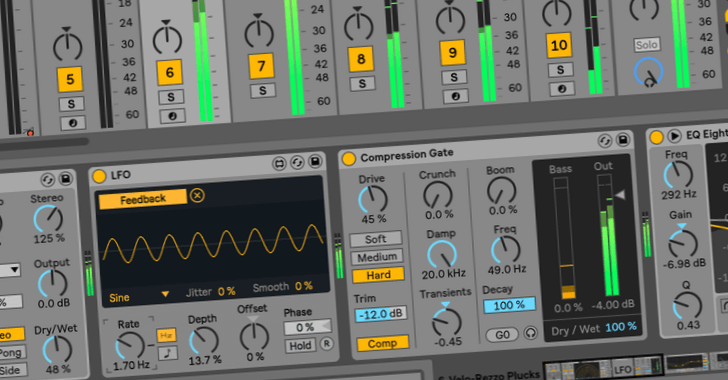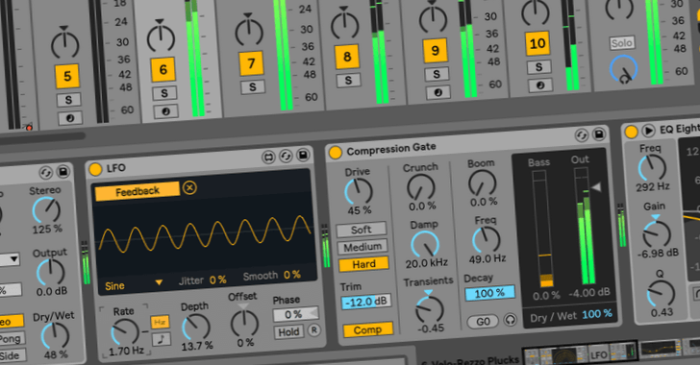If you are using a DAW such as Ableton Live, Logic Pro, Studio One, Bitwig, FL Studio, Reason, Cubase, or perhaps Pro Tools, there is a good chance you have also invested in a good number of additional audio plugins and virtual instruments.
But what about the stock plugins that come with your DAW? Edvīns Rakickis is back with an article on how to make the most of these plugins.

Stock plugins that come bundled with your DAW (Digital audio workstation) are some of the most underrated pieces of software in the whole wide world of audio production. Sometimes our minds trick us into thinking that a newer, “shinier” product is exactly what we need to overcome our mixing struggles, because the manufacturer promises a revolutionary software that, in essence, does exactly the same thing many others that came before it did.
Audio engineers from microphone manufacturer Violet Microphones share a few tips on how to get the most out of stock plugins you already have. This could teach you some useful tricks and maybe even help you save some money if you’re thinking about buying new software.
Know what you already have
If you have any of the major DAWs, you’re actually pretty well equipped from the start. You will definitely have gates, compressors, EQs and many other valuable plugins.
You might have never even seen the complete list of your stock plugins, so be sure to check the manual of your DAW, as usually you will find a list of them as well as instructions on what they are and how to use them.
Chances are, you will find that you have more than you thought!
It also helps to spend an hour or two just going through all of the plugins on a test project. If you open every plugin at least once, it’s more likely to remain in your memory and you might feel a lot more confident trying them out in a real-world situation.
Be sure to check out if the plugins have all the necessary bells and whistles, like side chain inputs and band-pass filters for extra functionality – more often than not, they will!
Listen with your ears, not with your eyes
It’s very easy to believe that a plugin with a nicer looking interface also sounds better, but that is not always so. Stock plugins of your DAW can actually sound excellent – even better than some of the separately purchased ones.
Believe it or not, makers of DAWs really know a thing or two about sound and code, even though their graphic design skills may be lacking at times.
Stock plugins also tend to be very well optimized to work with their native DAW, therefore reducing the CPU power consumption and ensuring maximum integration and stability.
They also are a lot more future-proof, as long as you are using the same DAW. Say you want to open your project in five years – even if all your third-party plugins have changed, the stock plugins will probably work just fine even after a couple major DAW revisions.
Cubase, for example, is known to support projects and plugins from four to five previous DAW revisions.
Try before you buy (yes, you can do that)
Sure, not everything can be done using stock plugins – many companies offer more flexible plugins that can do more in less steps, as well as nice, accurate emulations of analog gear and tape.
Some of the things that stock plugins may not be able to do are advanced multi-band compression or expansion, drum triggering from audio, multi-band distortion, harmonic saturation and linear phase mastering just to name a few.
Paid plugins may be just what you need and that is just fine. The great thing is that you can easily demo almost anything on the market at the moment if you have an iLok.
Get the demo, test and compare it with your stock plugins if in doubt, and then buy or subscribe to that product with confidence that your money will be well spent.
Pick your battles
Expensive plugins are not always the answer to the problems you may have.
Sometimes it’s wise to spend the cash elsewhere, like getting better room treatment and monitoring or investing in a good microphone or two – a decision that will significantly decrease the need for complex processing to salvage a less than optimal recording.
Whatever the case may be, follow these simple steps and you’ll be fine – know what you have, listen with your ears, try before buy and compare. Limitations can be a good way to challenge your creativity and unlock your full potential.
Editor’s note
If you enjoyed reading this, make sure to also check Edvīns’ other articles on recording vocals and mixing audio.
And let us know what your favorite stock plugins are in the comments below!

